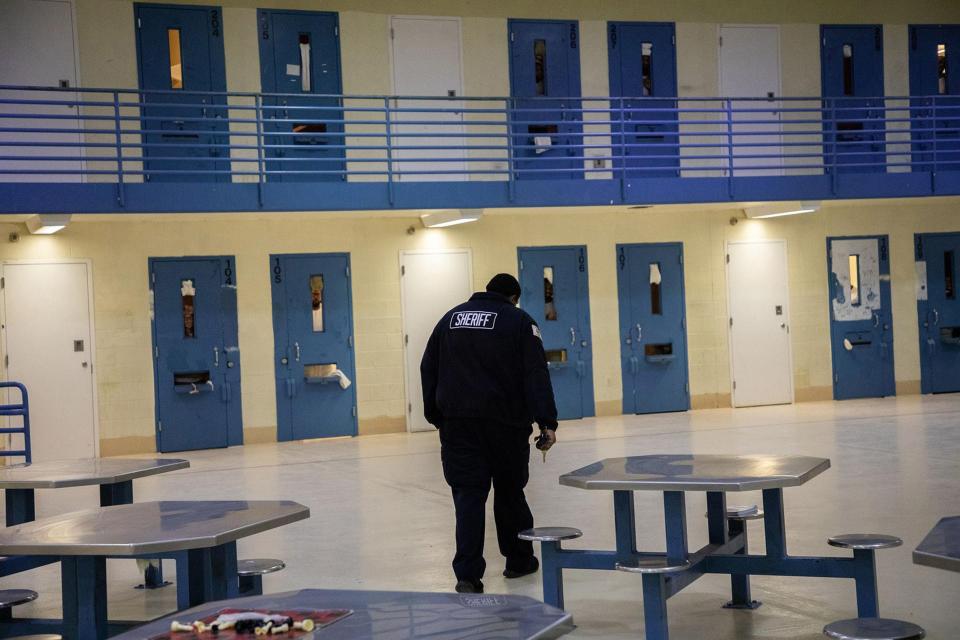As a psychologist and a jail warden, my duty was to bring humanity to an inhumane system
When it comes to the American criminal justice system, much of the story has already been written for people trying to cope with mental illness, addiction and trauma. Approximately 40% of people who are incarcerated have a history of mental illness, two-thirds have an active substance use disorder and nearly all have a history of trauma.
Help for those conditions over-incarceration is especially hard to attain for Black and brown people. This story has been a big part of my life.
I was 8 when more than a dozen police officers pounded on every corner of my family's North Carolina home, then burst inside and arrested my father for minor marijuana-related crimes.
SUBSCRIBE: Help support quality journalism like this.
During my freshman year in college, a psychology textbook instructed me that young Black people with risk factors like mine were “doomed.”
Like many other Black children who thrive despite limited resources and opportunity, I decided “doom” wasn’t the destination for me, nor should it be for any Black child. What these psychologists labeled as “doom” or “at-risk” actually described trauma, such as a child witnessing the arrest of a parent or violence in the neighborhood.
In 2008, I earned a doctoral degree in psychology to address trauma and bring humanity into our jails and prisons. This is where my story took a most unexpected turn.
COLUMN: Biden administration needs to walk the walk on second chances for prisoners
After serving for years as a staff and chief psychologist at Illinois' Cook County Jail, a bold sheriff appointed me warden. Sprawling across more than 90 acres, Cook County Jail is one of the largest single-site jails in the country. But those of us on the inside knew it as something Cook County Sheriff Tom Dart once called “the largest mental health hospital in the country.”

The jail epitomized how America uses incarceration as a catch-all for every social ill we face. As a Black woman, I did not want to be a representative of that dysfunction. I decided to decline the appointment as warden.
But my father persuaded me to take the job: “Seeing you as a Black woman psychologist will uplift the people who are in the jail. Seeing you will help people to feel safe and give them hope. I certainly would have slept better if I had a Black female psychologist as a warden.”
I put my training to work and tried to take on the toll that trauma inflicted on everyone at the jail: the people incarcerated, the staff and everyone's families.
BIDEN'S FIRST 100 DAYS: On racial and criminal justice, Biden has shown some promise, but little progress
The first thing we did was lift the wall between the people who were confined and the staff. We created more opportunities for interaction, and conversations about ways they could support each other, which was rare at the time.
We launched onsite programming for mental wellness, substance use, education and job training, which were often led by health care professionals, community organizations and correctional staff whom we trained.
Families of the people who were incarcerated were made part of conversations about ways to support their loved ones inside the jail. And we created a mental health hotline for families to use when they were concerned about the safety of loved ones.
Ultimately, we created more room for people who were incarcerated and staff to understand and relate to each other with humanity.
With these steps, we began to chip away at the failed approach of punishment and pain as the central purpose of incarceration. And although I believe my staff and I were able to restore hope for many, we were up against a system designed to resist healing as its central purpose.
This happened early this year in St. Louis, Missouri, where incarcerated people protested and took over the jail in response to COVID-19 treatment — all pleas for humanity.
POLICING THE USA: A look at race, justice, media
Today, I’m managing director of justice initiatives at Chicago Beyond, which invests in ideas, individuals and organizations fighting for all young people to achieve their fullest human potential. One of the ways it does this is by preventing and reversing the effects of trauma for young Chicagoans. I’m leading what I hope is another assault on trauma, but from a different angle.
There’s a justified call for radical change around incarceration in the United States, including the abolishment of the entire system. But that moment is likely years away. In the meantime, the people who run correctional facilities have the power to at least blunt the effects of trauma for everyone who moves between jail and prison walls. The community has the power to demand it.
A new road map I published for Columbia University’s Square One Project can be a practical tool for wardens and other officials who have an open mind for this sort of change.
Indeed, these correctional institutions epitomize everything wrong with the justice system. At the very least we can make them more humane, with a mission of healing.
Nneka Jones Tapia is the managing director of justice initiatives for Chicago Beyond and is an executive session member of Columbia University’s Square One Project.
You can read diverse opinions from our Board of Contributors and other writers on the Opinion front page, on Twitter @usatodayopinion and in our daily Opinion newsletter. To respond to a column, submit a comment to letters@usatoday.com.
This article originally appeared on USA TODAY: Prison reform: Ex-Cook County warden wants to bring humanity to system

